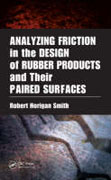
Analyzing friction in the design of rubber products and their paired surfaces: designing rubber products and their paired surfaces
Smith, Robert Horigan
Based on the author's extensive analytical evidence, which indicates the existence of microhysteresis in sliding rubber, "Rubber Friction" presents a unified theory of surface deformation hystersis that allows for the design of elastometric products and paired surfaces. This theory results from over 30 different independent rubber friction tests that suggest a fourth rubber friction force. This book provides a detailed discussion of the microhysteresis mechanism and examines arguments from various researchers. With numerous design and how-to examples, this comprehensive text offers practical guidelines and examples to assist in implementing this theory into the analysis and design process. INDICE: Preface Introduction Historical Background Purposes of the Book The Unified Theory of Rubber Friction Surface Deformation Hysteresis in Rubber Differences between Metallic and Rubber Friction Mechanisms Consequences Stemming from Use of the Traditional Metallic Friction Approach to Rubber Friction Analysis Approach to the Subject Organization of the Book Metallic Coefficient of Friction Introduction Smooth Metal Friction Adhesion Theory of Smooth MetalFriction Origin of the Friction Force between Smooth Metals Rough Metal Friction Laws of Metallic Friction Rubber Friction Mechanisms Introduction Rubber Friction Coefficient Decreases with Increasing Load Adhesion as a Rubber Friction Mechanism Linking Rubber Friction to the Real Area of Contact Hertz Equation Bulk Deformation Hysteresis in Rubber Concurrently Acting Rubber Friction Mechanisms Van der Waals' Adhesion and Surface Deformation Hysteresis in Rubber Adhesion, Bulk Deformation Hysteresis, and Wear in Sliding Rubber Expressions for Bulk Deformation Hysteresis in Rubber Modified Hertz Equation Schallamach Waves Elastomeric Friction Microhysteretic Contributions to Wet Rubber Friction Metallic Coefficient-of-Friction Equation Does Not Apply to Rubber Introduction Coefficient of Rubber Friction on Dry, Smooth Surfaces Coefficient of Rubber Friction on Dry, Textured Surfaces Coefficient of Rubber Friction on Wet, Smooth Surfaces Coefficient of Rubber Friction on Wet, Textured Surfaces Constant (Metallic) Coefficient-of-Friction Equation Not Applicable to Rubber A Unified Theory of Rubber Friction Introduction Rubber Microhysteresis Development on Macroscopically Smooth Surfaces Rubber Microhysteresis Development on Macroscopically Rough Surfaces Characteristics of the Rubber Microhysteresis Mechanism No-Load Adhesion Hypothesis Rubber Surface Deformation Hysteresis Testing A Unified Theory of Rubber Friction The Rubber Adhesion-Transition Phenomenon Introduction Further Aspects of the Rubber Adhesive Friction Mechanism Adhesive Friction of Metal and Nonelastomeric Plastics in the Elastic Loading Range Determinants Controlling the Value of PNt Controlling Adhesion-Transition Pressure to Optimize Friction Development "Low" muA Values in the Low Loading RangeMicrohysteretic Friction in Dry Rubber Products Introduction Microhysteresis in Automotive Tire Rubber in Dry Conditions Microhysteresis in Dry Aircraft Tires Rubber Microhysteresis in Dry Footwear Materials Microhysteresis in Dry Rubber Belting Rubber Adhesion-Transition Pressure Phenomenon on MacroscopicallyRough Surfaces Microhysteresis in Wet Rubber Products Introduction Effects ofWet Lubricants on the Rubber Adhesion Mechanism Microhysteresis in AutomotiveTire Rubber under Wet Conditions Microhysteresis in Wet Aircraft Tires RubberMicrohysteresis in Wet Footwear Outsoles Ramifications of the Presence of Microhysteresis in Wet Rubber Products Rubber Adhesion-Transition Phenomenon on Wet Surfaces Rubber Microhysteresis in Static Friction Testing Introduction Does Static Friction in Rubber Exist? Two Portable Static Friction Testing Devices Definition of Static Friction Rubber Microhysteresis in Static Friction Testing Independence of the Rubber Microhysteresis Force in Static Friction Testing Adhesion and Rubber Microhysteresis in VIT Testing Bias in Portable Walking-Surface Slip-Resistance Testers Introduction Remediable Inertial Bias in Portable Walking-Surface Slip-Resistance Testers Irremediable Inertial Bias in Portable Walking-Surface Slip-Resistance Testers Remediable Residence-Time Bias inStatic Friction Testing Irremediable Adhesion-Transition Bias in Portable Walking-Surface Slip-Resistance Testers Contact-Time Bias for Tribometer Comparability Nonscientific Application of the Laws of Metallic Friction to Rubber Tires Operated on Pavements Introduction Comparing the Characteristics of Rubber Friction to Metallic Friction Effects of the Development of Microhysteretic Forces on Tire Friction Analysis Comparability of Rubber Friction Testing Data Inadvertent Misapplication of the Laws of Metallic Friction to Rubber Tires in ASTM Test Standards Inadvertent Misapplication of the Laws of Metallic Friction to Rubber Tires in Motor Vehicle Accident Reconstruction Inadvertent Misapplication of the Laws of Metallic Friction to Rubber Tires in the Geometric Design of Roadways Friction Analysis in the Design of Rubber Tires and Their Contacted Pavements Introduction... ETC.
- ISBN: 978-0-8493-8136-2
- Editorial: CRC Press
- Encuadernacion: Rústica
- Páginas: 424
- Fecha Publicación: 18/03/2008
- Nº Volúmenes: 1
- Idioma: Inglés
